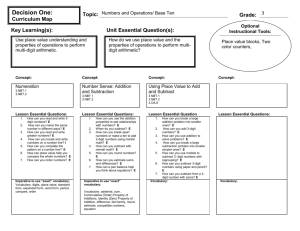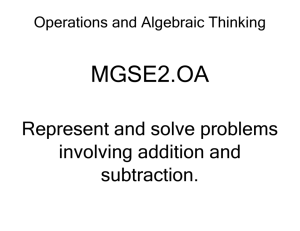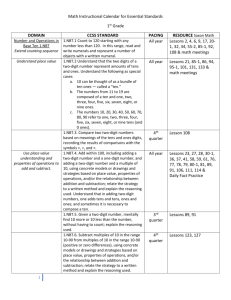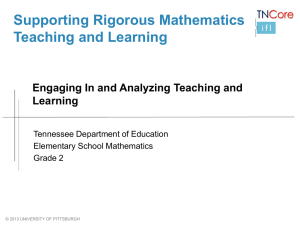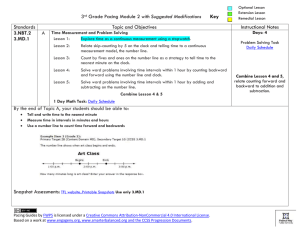Student Growth Objective Form
advertisement
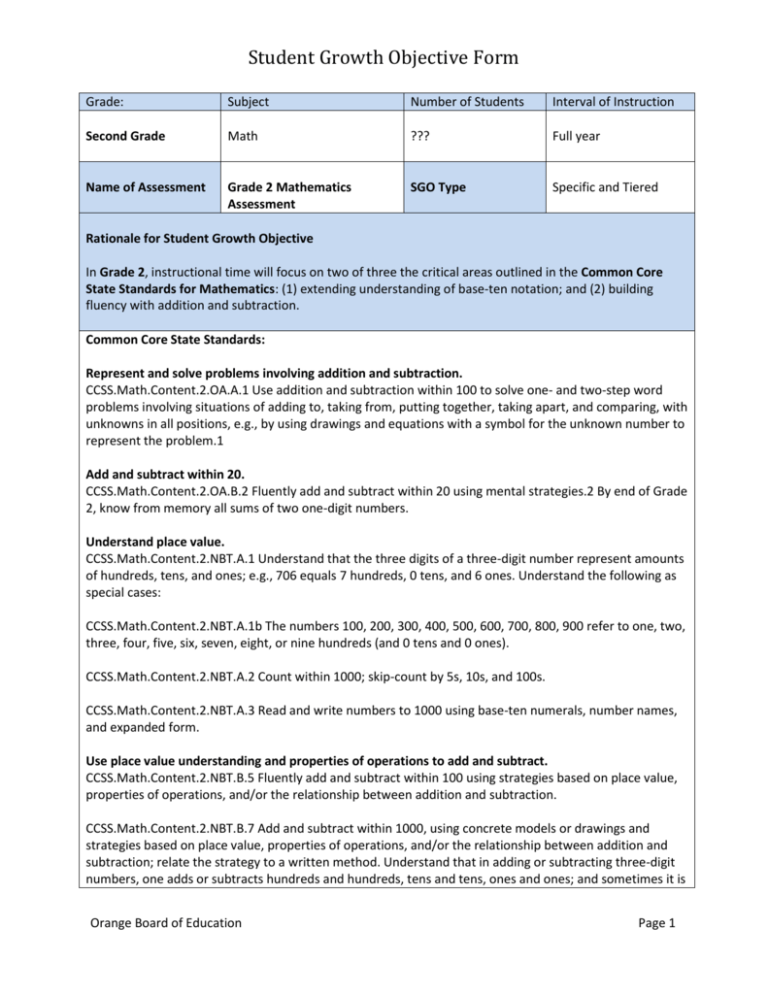
Student Growth Objective Form Grade: Subject Number of Students Interval of Instruction Second Grade Math ??? Full year Name of Assessment Grade 2 Mathematics Assessment SGO Type Specific and Tiered Rationale for Student Growth Objective In Grade 2, instructional time will focus on two of three the critical areas outlined in the Common Core State Standards for Mathematics: (1) extending understanding of base-ten notation; and (2) building fluency with addition and subtraction. Common Core State Standards: Represent and solve problems involving addition and subtraction. CCSS.Math.Content.2.OA.A.1 Use addition and subtraction within 100 to solve one- and two-step word problems involving situations of adding to, taking from, putting together, taking apart, and comparing, with unknowns in all positions, e.g., by using drawings and equations with a symbol for the unknown number to represent the problem.1 Add and subtract within 20. CCSS.Math.Content.2.OA.B.2 Fluently add and subtract within 20 using mental strategies.2 By end of Grade 2, know from memory all sums of two one-digit numbers. Understand place value. CCSS.Math.Content.2.NBT.A.1 Understand that the three digits of a three-digit number represent amounts of hundreds, tens, and ones; e.g., 706 equals 7 hundreds, 0 tens, and 6 ones. Understand the following as special cases: CCSS.Math.Content.2.NBT.A.1b The numbers 100, 200, 300, 400, 500, 600, 700, 800, 900 refer to one, two, three, four, five, six, seven, eight, or nine hundreds (and 0 tens and 0 ones). CCSS.Math.Content.2.NBT.A.2 Count within 1000; skip-count by 5s, 10s, and 100s. CCSS.Math.Content.2.NBT.A.3 Read and write numbers to 1000 using base-ten numerals, number names, and expanded form. Use place value understanding and properties of operations to add and subtract. CCSS.Math.Content.2.NBT.B.5 Fluently add and subtract within 100 using strategies based on place value, properties of operations, and/or the relationship between addition and subtraction. CCSS.Math.Content.2.NBT.B.7 Add and subtract within 1000, using concrete models or drawings and strategies based on place value, properties of operations, and/or the relationship between addition and subtraction; relate the strategy to a written method. Understand that in adding or subtracting three-digit numbers, one adds or subtracts hundreds and hundreds, tens and tens, ones and ones; and sometimes it is Orange Board of Education Page 1 Student Growth Objective Form necessary to compose or decompose tens or hundreds. CCSS.Math.Content.2.NBT.B.8 Mentally add 10 or 100 to a given number 100–900, and mentally subtract 10 or 100 from a given number 100–900. CCSS.Math.Content.2.NBT.B.9 Explain why addition and subtraction strategies work, using place value and the properties of operations. Note: Teacher will formally assess student attainment of the critical concepts on a beginning of the year, mid-year, and end of the year math assessment. Teacher will also use data from the previous school year such as Model Curriculum Benchmark Assessments to inform practice. Throughout the school year, the teacher will continuously assess student progress (both formally and informally) with math work sampling, portfolio maintenance, anecdotal notes another formative assessment measures such to monitor and adjust instructional practice. Students Growth Objective: By April 2014, 85% of the students within each Tier will have obtained an average score of moderate, solid or distinguished command on each item on the Math Assessment, advancing a minimum of 1-2 Performance Levels (see below). Tier 1 (Low Level) Average end of the year score will be Level 3: Moderate Command Tier 2 (Mid Level) Average end of the year score will be Level 4: Solid Command Tier 3 (High Level) Average end of the year score will be Level 5: Distinguished Command Performance Levels Descriptors (PLDs) Level 5: Distinguished Command Students performing at this level demonstrate a distinguished command of the knowledge, skills, and practices embodied within the Common Core State Standards for Second Grade focused on representing and comparing whole numbers assessed at their grade level. Level 4: Solid Command Students performing at this level demonstrate a solid command of the knowledge, skills, and practices embodied within the Common Core State Standards for Second Grade focused on representing and comparing whole numbers assessed at their grade level. Orange Board of Education Page 2 Student Growth Objective Form Level 3: Moderate Command Students performing at this level demonstrate a moderate command of the knowledge, skills, and practices embodied within the Common Core State Standards for Second Grade focused on representing and comparing whole numbers assessed at their grade level. Level 2: Partial Command Students performing at this level demonstrate a partial command of the knowledge, skills, and practices embodied within the Common Core State Standards for Second Grade focused on representing and comparing whole numbers assessed at their grade level. Level 1: Minimal Command Students performing at this level demonstrate a minimal command of the knowledge, skills, and practices embodied within the Common Core State Standards for Second Grade focused on representing and comparing whole numbers assessed at their grade level. Orange Board of Education Page 3 Student Growth Objective Form Baseline Data (Please include what you know about your students’ performance/skills/achievement levels at the beginning of the year, as well as any additional student data or background information used in setting your objective.) Teacher will use the Grade 2 Mathematics Pre Assessment to acquire baseline data. Pre-Assessments are Observation/Interview Checklists tied to Performance Tasks designed to determine the degree to which a student demonstrates particular skills that are deemed important for students to be successful in specific grade level content. Performance Level Distinguished Command (5) (Rounded Averages) Solid Command (4) Moderate Command (3) Partial Command (2) Minimal Command (1) Number of Students at each Level Preparedness Level Number of Students in Each Group (Total) Target Score on PostAssessment (%) Number of Students Required for “Full Attainment” Tier I (Low Level) PLD 1 and 2 Tier II (Mid Level) PLD 3 Tier III (High Level) PLD 4 and 5* * It is expected that students in Performance Level 5 maintain a level of distinguished command, making advancements within each indicator on the Observation Checklist. Scoring Plan Preparedness Group Target Score on Final Assessment Orange Board of Education Objective Attainment Level Based on Percent and Number of Students Achieving Target Score Exceptional (4) Full (3) Partial (2) Insufficient (1) Page 4 Student Growth Objective Form Approval of Student Growth Objective Teacher _________________ Signature_______________ Date Submitted_______________ Evaluator ________________ Signature _______________ Date Approved _______________ Results of Student Growth Objective Preparedness Number of Objective Group Students at Attainment Target Score Level SGO Score Average Objective Attainment Level Teacher ________________________ Evaluator _________________ _____ Orange Board of Education Date _________________ Page 5
